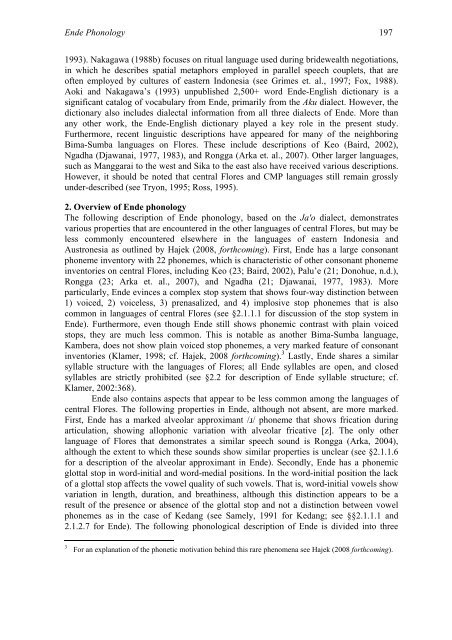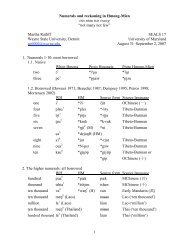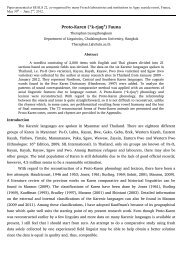proto-southwestern-tai revised: a new reconstruction - seals 22
proto-southwestern-tai revised: a new reconstruction - seals 22
proto-southwestern-tai revised: a new reconstruction - seals 22
You also want an ePaper? Increase the reach of your titles
YUMPU automatically turns print PDFs into web optimized ePapers that Google loves.
Ende Phonology 197<br />
1993). Nakagawa (1988b) focuses on ritual language used during bridewealth negotiations,<br />
in which he describes spatial metaphors employed in parallel speech couplets, that are<br />
often employed by cultures of eastern Indonesia (see Grimes et. al., 1997; Fox, 1988).<br />
Aoki and Nakagawa’s (1993) unpublished 2,500+ word Ende-English dictionary is a<br />
significant catalog of vocabulary from Ende, primarily from the Aku dialect. However, the<br />
dictionary also includes dialectal information from all three dialects of Ende. More than<br />
any other work, the Ende-English dictionary played a key role in the present study.<br />
Furthermore, recent linguistic descriptions have appeared for many of the neighboring<br />
Bima-Sumba languages on Flores. These include descriptions of Keo (Baird, 2002),<br />
Ngadha (Djawanai, 1977, 1983), and Rongga (Arka et. al., 2007). Other larger languages,<br />
such as Manggarai to the west and Sika to the east also have received various descriptions.<br />
However, it should be noted that central Flores and CMP languages still remain grossly<br />
under-described (see Tryon, 1995; Ross, 1995).<br />
2. Overview of Ende phonology<br />
The following description of Ende phonology, based on the Ja'o dialect, demonstrates<br />
various properties that are encountered in the other languages of central Flores, but may be<br />
less commonly encountered elsewhere in the languages of eastern Indonesia and<br />
Austronesia as outlined by Hajek (2008, forthcoming). First, Ende has a large consonant<br />
phoneme inventory with <strong>22</strong> phonemes, which is characteristic of other consonant phoneme<br />
inventories on central Flores, including Keo (23; Baird, 2002), Palu’e (21; Donohue, n.d.),<br />
Rongga (23; Arka et. al., 2007), and Ngadha (21; Djawanai, 1977, 1983). More<br />
particularly, Ende evinces a complex stop system that shows four-way distinction between<br />
1) voiced, 2) voiceless, 3) prenasalized, and 4) implosive stop phonemes that is also<br />
common in languages of central Flores (see §2.1.1.1 for discussion of the stop system in<br />
Ende). Furthermore, even though Ende still shows phonemic contrast with plain voiced<br />
stops, they are much less common. This is notable as another Bima-Sumba language,<br />
Kambera, does not show plain voiced stop phonemes, a very marked feature of consonant<br />
inventories (Klamer, 1998; cf. Hajek, 2008 forthcoming). 3 Lastly, Ende shares a similar<br />
syllable structure with the languages of Flores; all Ende syllables are open, and closed<br />
syllables are strictly prohibited (see §2.2 for description of Ende syllable structure; cf.<br />
Klamer, 2002:368).<br />
Ende also con<strong>tai</strong>ns aspects that appear to be less common among the languages of<br />
central Flores. The following properties in Ende, although not absent, are more marked.<br />
First, Ende has a marked alveolar approximant /�/ phoneme that shows frication during<br />
articulation, showing allophonic variation with alveolar fricative [z]. The only other<br />
language of Flores that demonstrates a similar speech sound is Rongga (Arka, 2004),<br />
although the extent to which these sounds show similar properties is unclear (see §2.1.1.6<br />
for a description of the alveolar approximant in Ende). Secondly, Ende has a phonemic<br />
glottal stop in word-initial and word-medial positions. In the word-initial position the lack<br />
of a glottal stop affects the vowel quality of such vowels. That is, word-initial vowels show<br />
variation in length, duration, and breathiness, although this distinction appears to be a<br />
result of the presence or absence of the glottal stop and not a distinction between vowel<br />
phonemes as in the case of Kedang (see Samely, 1991 for Kedang; see §§2.1.1.1 and<br />
2.1.2.7 for Ende). The following phonological description of Ende is divided into three<br />
3 For an explanation of the phonetic motivation behind this rare phenomena see Hajek (2008 forthcoming).





